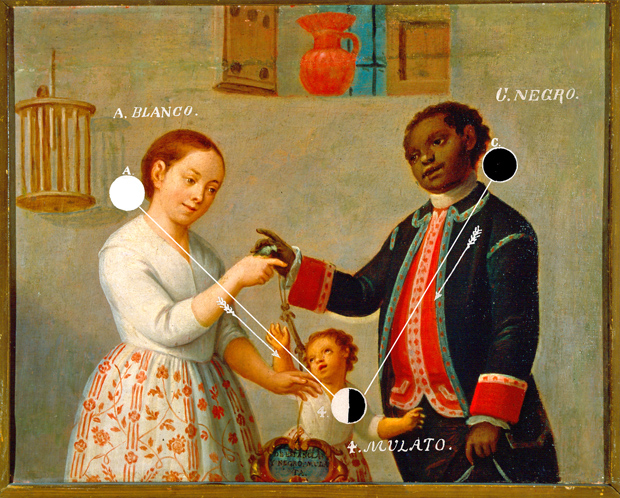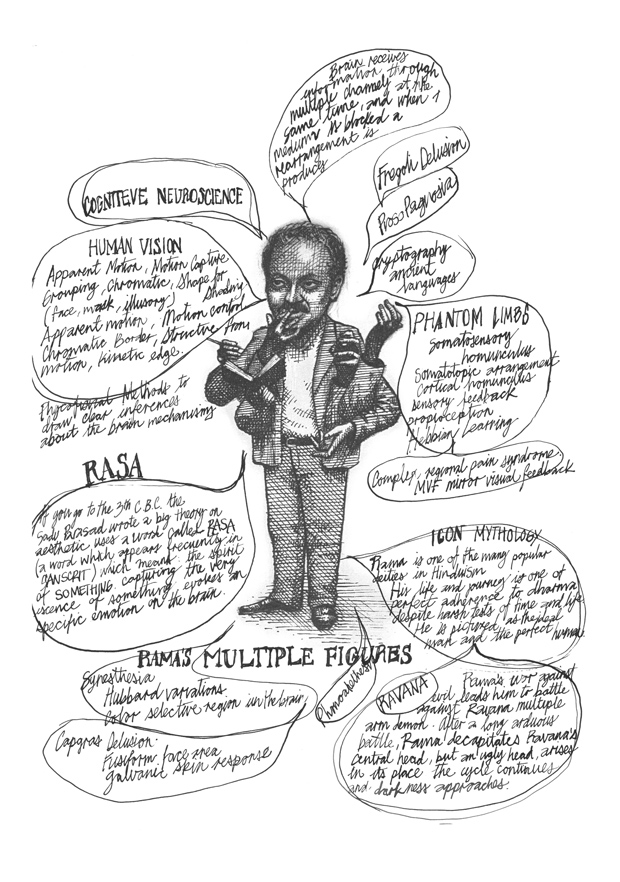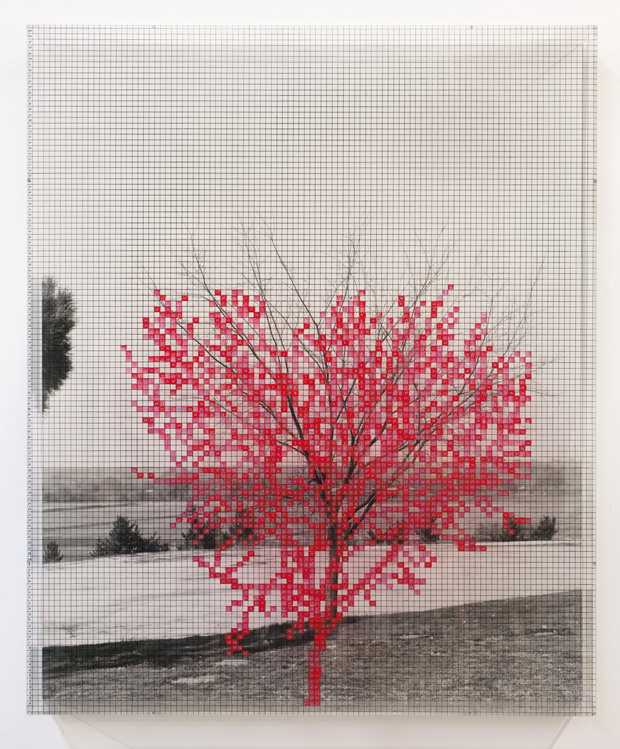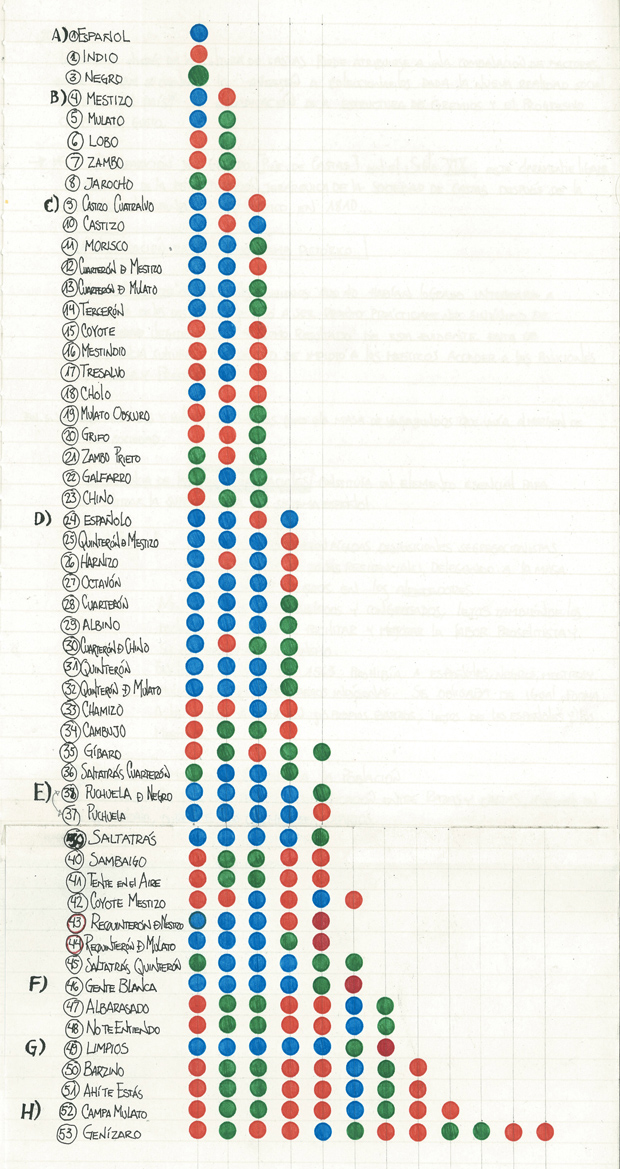
By:
- Sheena Ghanbari
Published Date
By:
- Sheena Ghanbari
Share This:
Art and Science Have a Chat in ‘ANOMALIA’

Erick Meyenberg, De Española y Negro sale Mulato, 2010. Courtesy of the artist and Galería Caja Blanca.
In scientific research, an anomalous finding can be cast aside because it falls outside of the typical and does not fit cleanly in a normal distribution curve. This very deviation is the premise for the “ANOMALIA” exhibition at the University Art Gallery Feb. 16 through May 18. The show’s title stems from the Latin root for “anomaly,” or irregularity. The exhibition brings anomalous findings to the forefront and features four international contemporary artists whose work engages scientific models of research and representation: Charles Gaines, Erick Meyenberg, Erick Beltrán and Jorge Satorre.

Erick Beltrán and Jorge Satorre, Illustration #55 of Modeling Standard (by Jorge Aviña), 2010. Courtesy of the artists and Labor, Mexico City.
“ANOMALIA” is organized by distinguished independent curator and former Museum of Contemporary Art San Diego associate curator Lucía Sanromán, specifically for the University Art Gallery and the UC San Diego campus.
Sanromán said she is interested in the “opposition of aesthetic rapture versus scientific practice,” explaining that the subjective nature of the arts has an interesting contrast to scientific research, which generally “asks human for objective observation and judgment.”
The featured artists employ empirical systems in their practice, including ethnographic data research, cognitive modeling and systems theory, but Sanromán says she is not aiming to teach the viewer about the intersections of art and science. Instead, she said, she is interested in “the various ways by which the work of these artists suggests that by bringing together science with aesthetics, both orders are interrupted and this creates a space for dialogue.”
Participating artist Erick Meyenberg, for example, presents a four-dimensional diagram of the genetic coding of Mexicans, from the colonial period through today. Using 22 individuals as subjects, Meyenberg calculated the percentage of indigenous, white and black “blood” in each individual to create a three-dimensional genetic diagram. By plotting these findings the artist generates an immersive colored light and sound installation that is a symbolic reflection of the socio-economical structure that prevails in Mexico and other countries. He interprets important scientific findings, but the end product functions as an art piece.

Charles Gaines, Numbers & Trees V, Landscape, #1, 1989, collection of Peter Gelles and Eve Steele. Courtesy of Susanne Vielmetter Los Angeles Projects. Photo credit Robert Wedemeyer.
The University Art Gallery has organized complementary events to reveal abstract concepts embedded in the works on display. On February 15, from 6:30 to 8 p.m., participating artist Charles Gaines engaged in a lively discussion with Rafael Núñez, associate professor in the department of cognitive science, to explore the cognitive underpinnings of his work in “ANOMALIA.” Gaines is a celebrated conceptual artist and CalArts professor, and his work provides an important theoretical and historical context to the younger artists. His interest lies in how mathematics can function as a language and the exhibition presents two bodies of work Gaines created in the 1980s: “Landscape: Assorted Trees with Regressions” and “Numbers & Trees.” These series combine photographic images and photo-realistic drawings with text and question the means by which images are read, understood and experienced.
The exhibition’s opening reception was on February 16 from 5:30 to 8:30 p.m. At the opening reception, participating artists Erick Beltrán and Jorge Satorre presented a talk titled “Modeling Standard: A Guided Tour.” Beltrán and Satorre take a departure point from the theory of the “Standard Model” in particle physics, which states that everything is made of 12 fundamental particles. During the reception, the artists created a jam-packed graphic novel containing personal histories and allusions to historical characters, which will nowremain on display in “ANOMALIA.” The exhibit also features new material created by Beltrán and Satorre in response to a special interview between them and renowned professor of psychology and neurosciences Vilayanur Subramanian Ramachandran, director of the Center for Brain and Cognition at UC San Diego.
Sanromán designed the exhibition with the campus community in mind: “I hope this exhibit will appeal to UCSD artists and scientists alike,” she said, “and generate conversations across departments.”
The exhibition is free and open to the public and also welcomes the broader community. To learn more about “ANOMALIA” and its participating artists please visit: http://uag.ucsd.edu/exhibitions/Anomalia-LuciaSanroman.shtml

Erick Meyenberg, Mexican Genealogy, 2010. Courtesy of the artist and Galería Caja Blanca
Share This:
You May Also Like
Stay in the Know
Keep up with all the latest from UC San Diego. Subscribe to the newsletter today.


